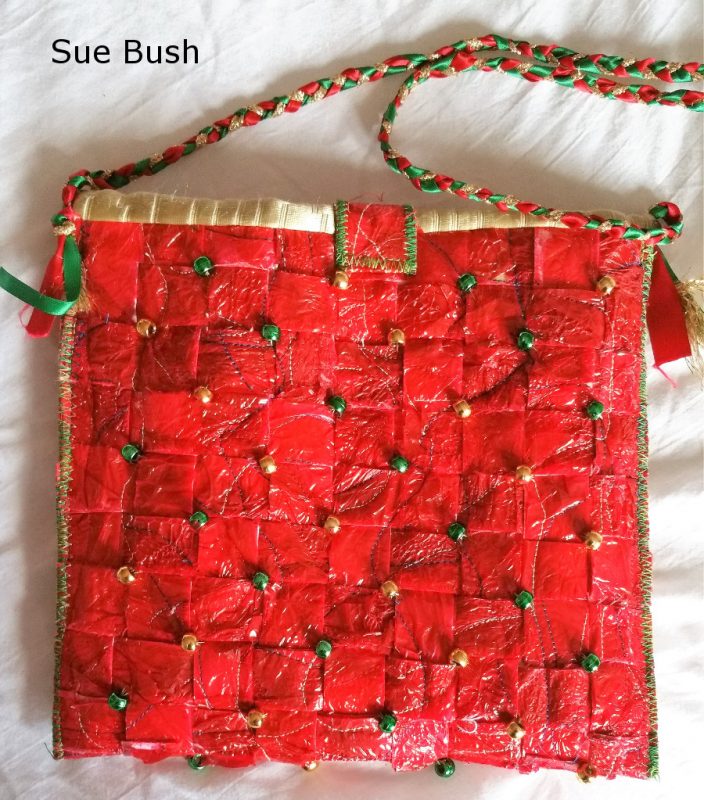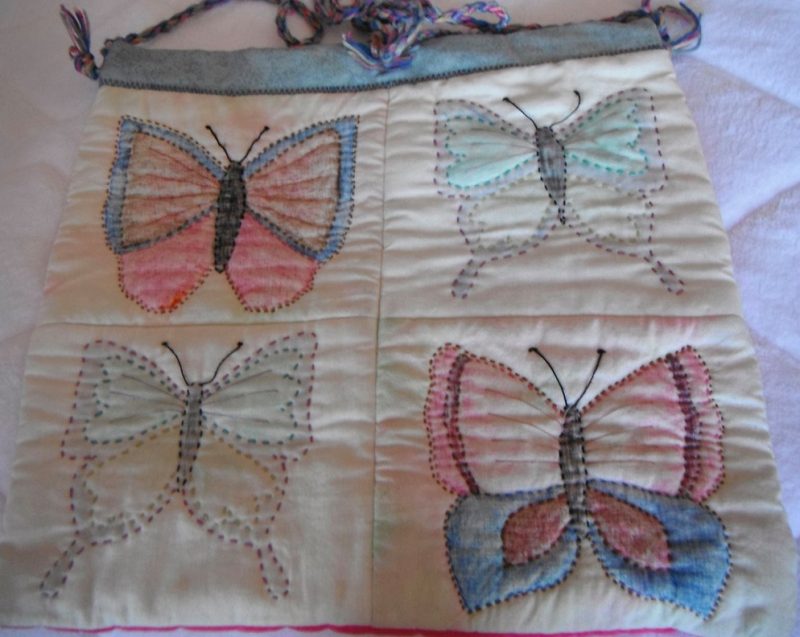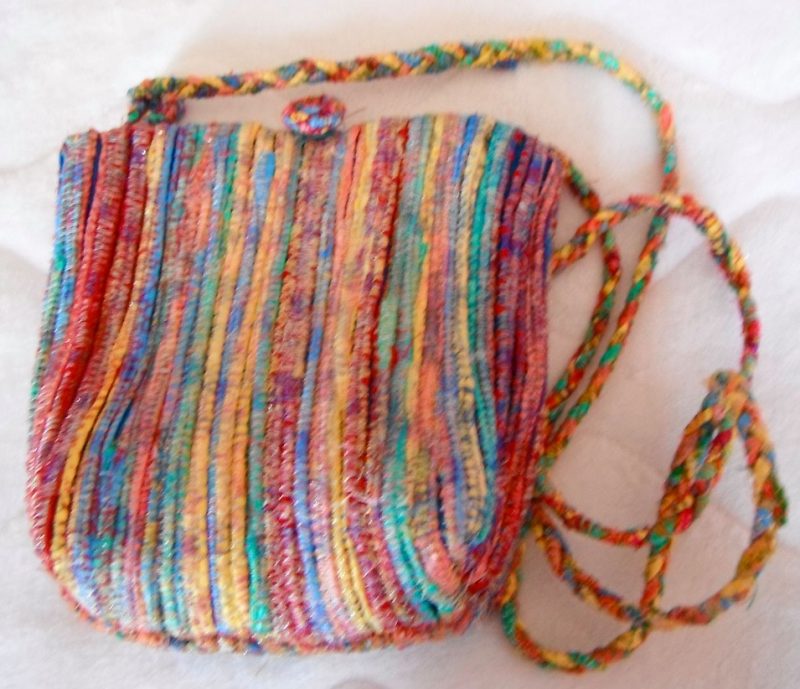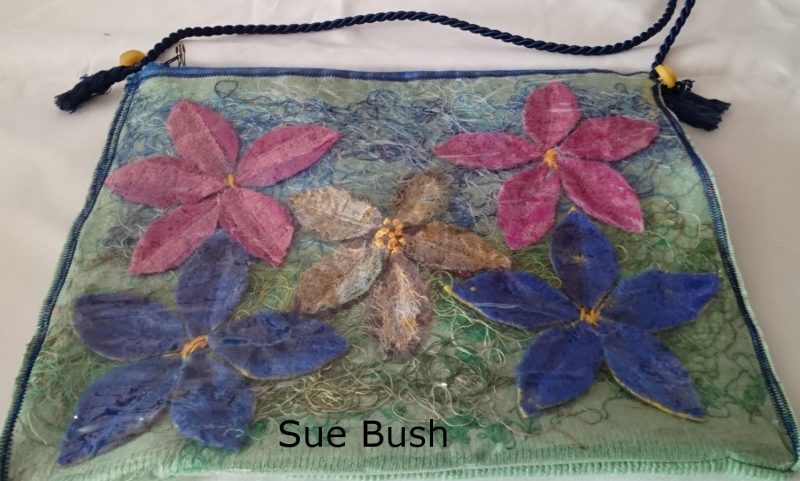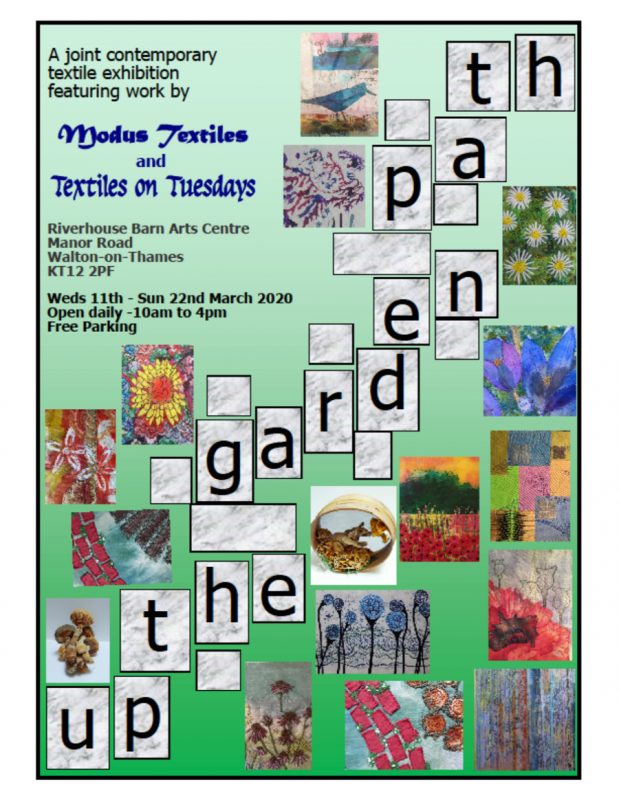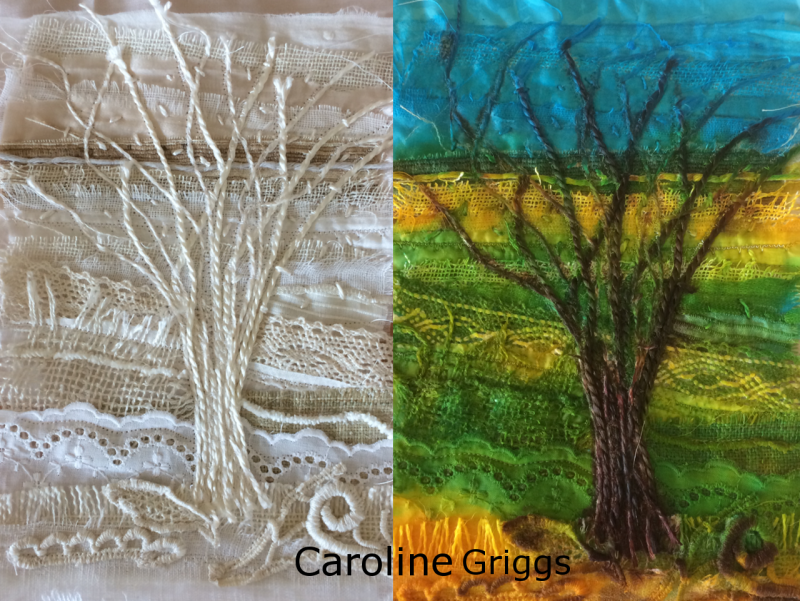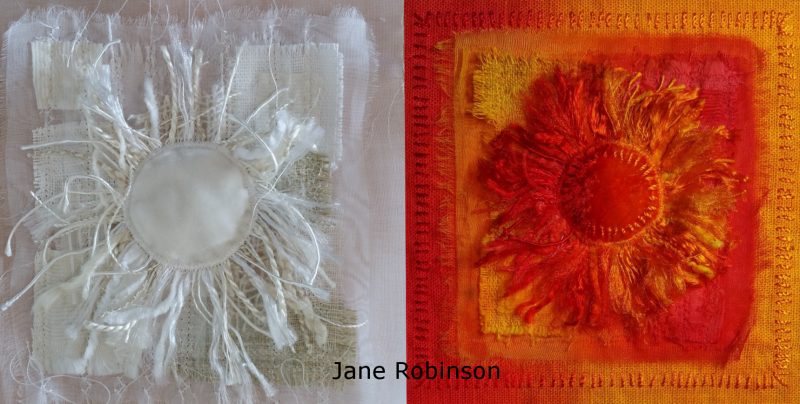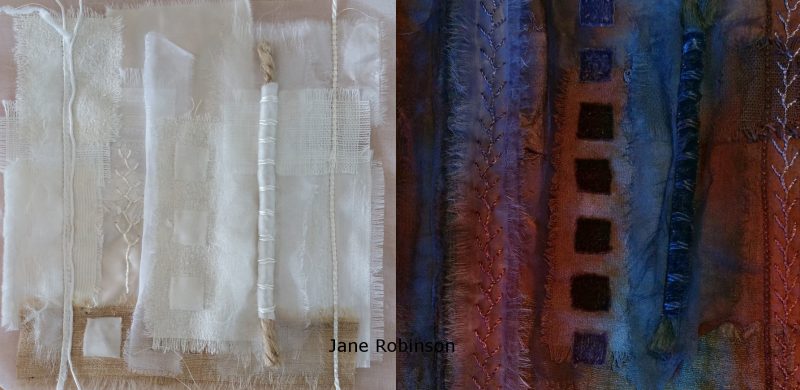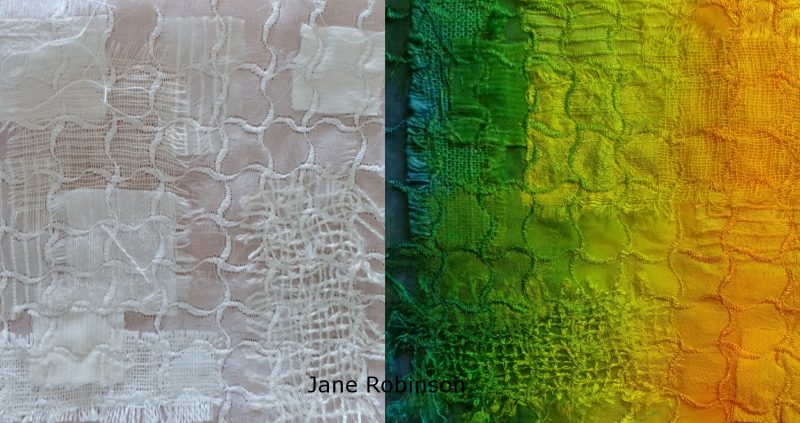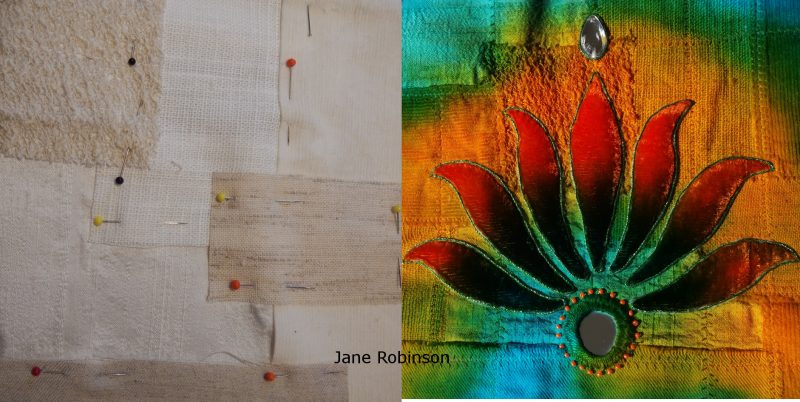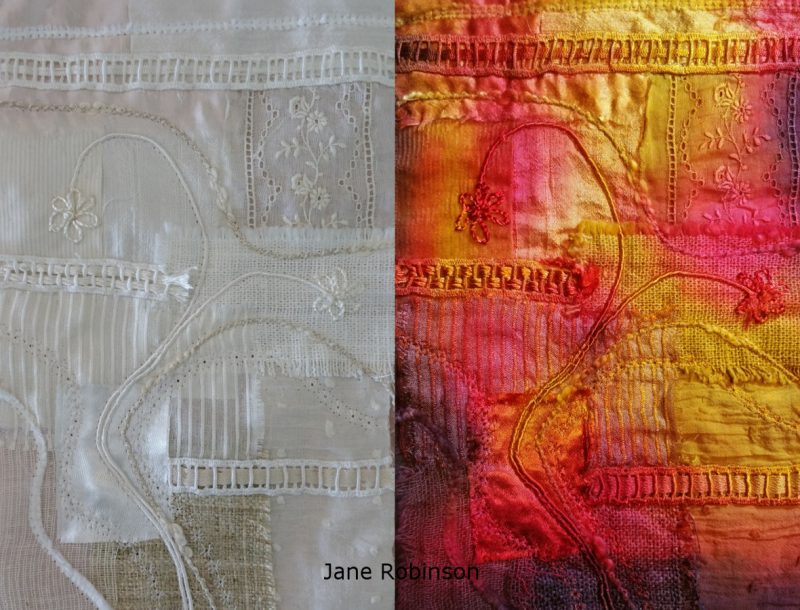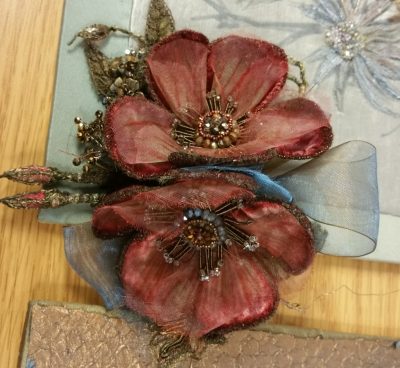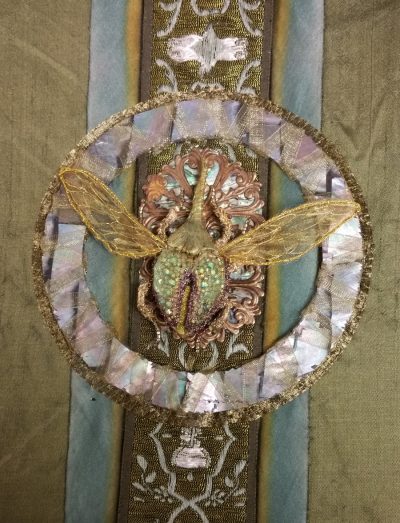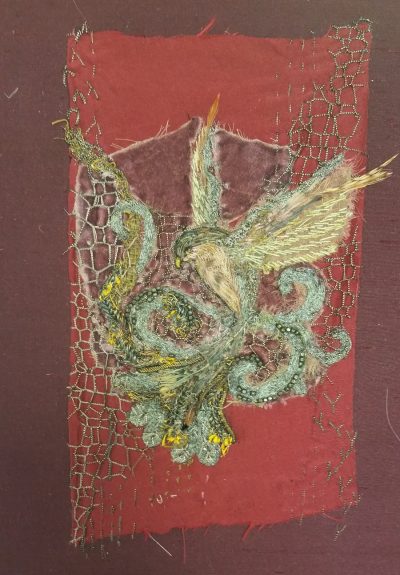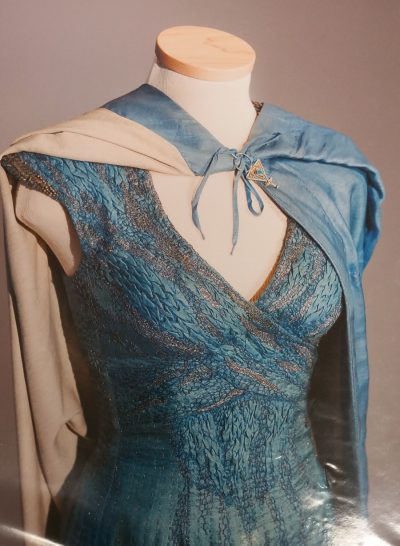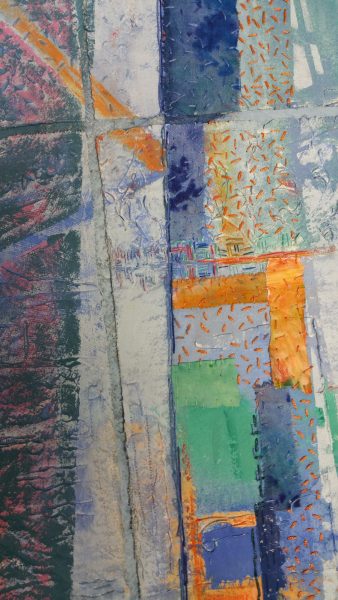Tag: embroidery
‘Up the Garden Path’ Exhibition
Christmas meeting, and the ‘Take Two’ Challenge
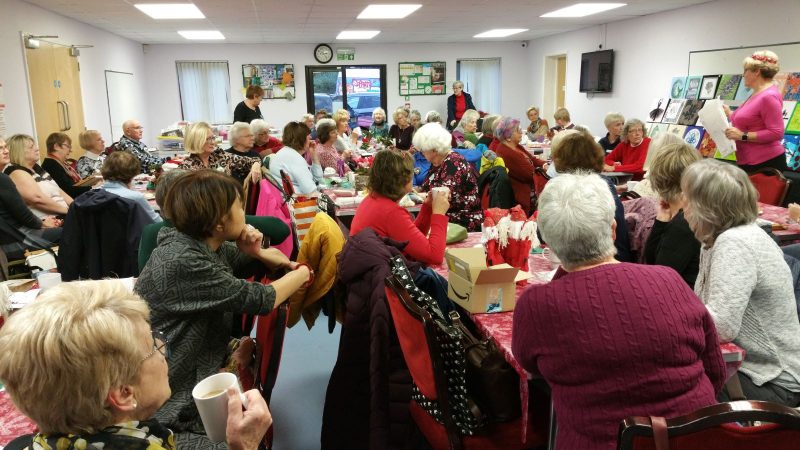 There was a great turn-out for the Christmas meeting, and it was a lovely afternoon of chat, stitch and cake. Highlight of the afternoon was viewing the results of the ‘Take Two’ challenge (reminder: the challenge was to stitch a piece to be presented on a pre-set canvas size, using only two colours). There was a grand total of 43 entries, and everyone was impressed by the variety and quality of the work. Entries included a wide range of modern, traditional, hand-stitch, machine-stitch etc., and it really reminded us all what a varied group of stitchers we are. The £1 per vote charge raised £76 for the Air Ambulance.
There was a great turn-out for the Christmas meeting, and it was a lovely afternoon of chat, stitch and cake. Highlight of the afternoon was viewing the results of the ‘Take Two’ challenge (reminder: the challenge was to stitch a piece to be presented on a pre-set canvas size, using only two colours). There was a grand total of 43 entries, and everyone was impressed by the variety and quality of the work. Entries included a wide range of modern, traditional, hand-stitch, machine-stitch etc., and it really reminded us all what a varied group of stitchers we are. The £1 per vote charge raised £76 for the Air Ambulance.
Here are a few of the entries, with people studying them and trying to decide which to vote for. You can see the winning entries below that. At a later date, I’ll put up an image of each entry – that will take a little longer, so I wanted to get the winning ones up sooner rather than later.
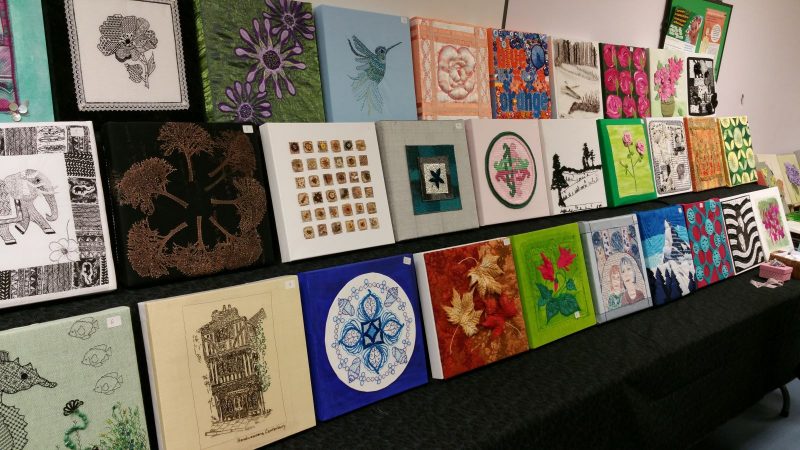
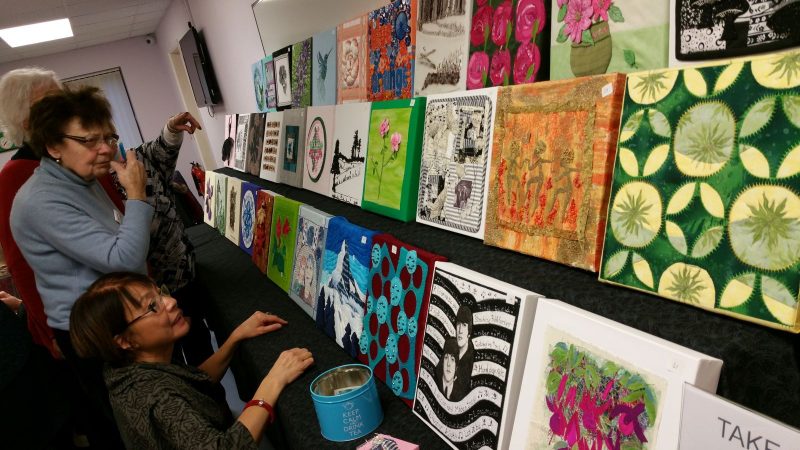
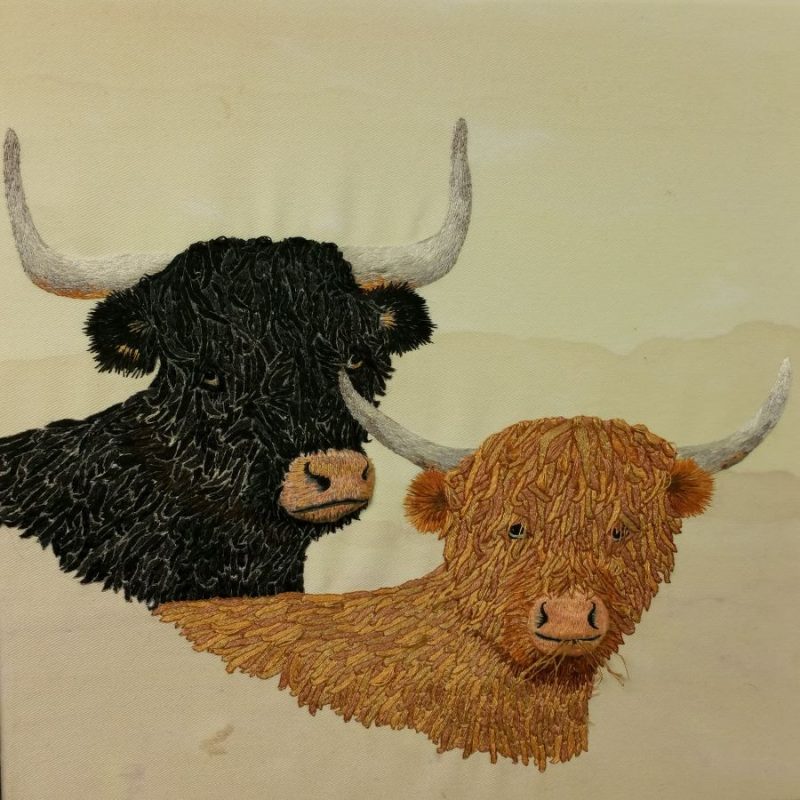
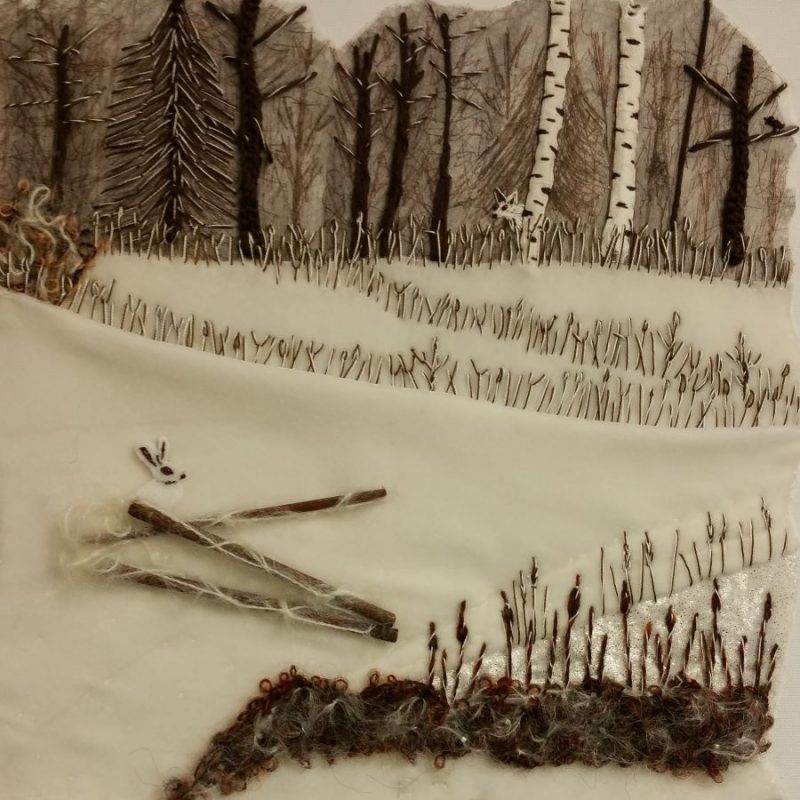
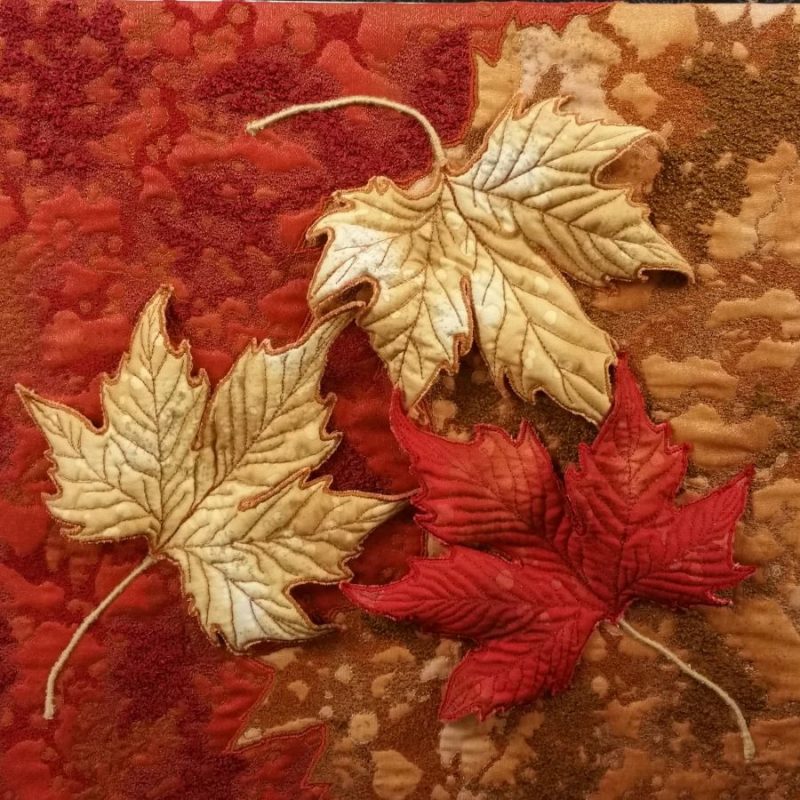
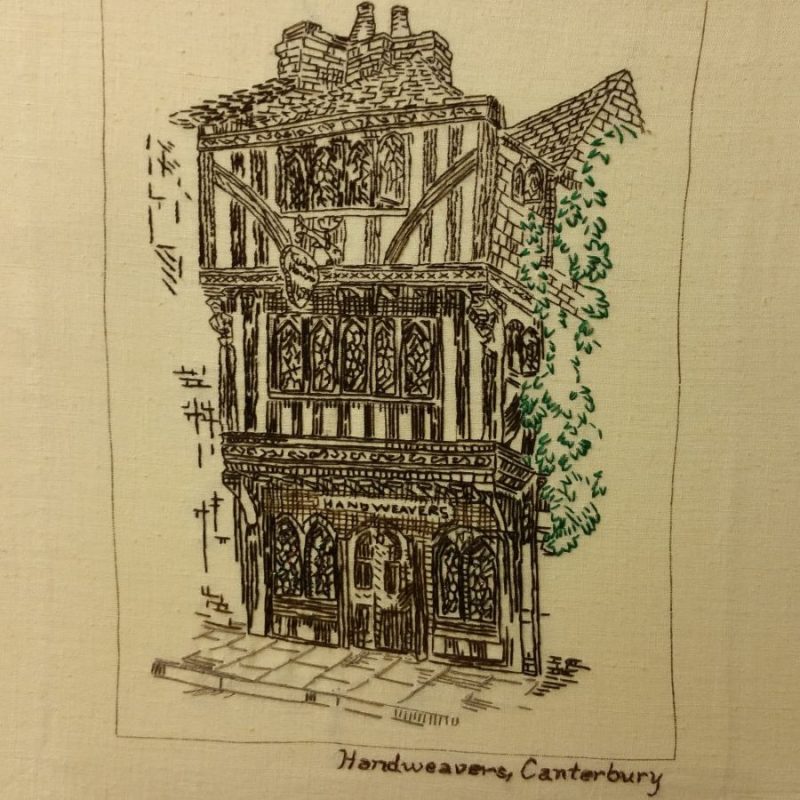
Summer-School ‘show and tell’.
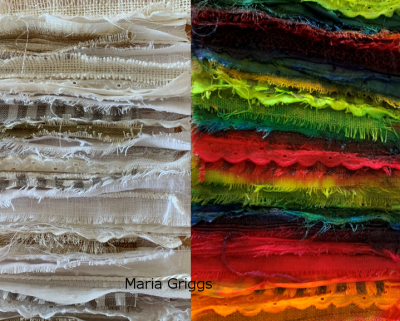 The 2019 AGM went very smoothly. Anne Turner gave an account of an active and happy year stitching, and described the wide range of talks and workshops that take place each month. The Treasurer’s report showed a stable and healthy situation; and willing volunteers came forward to replace the three committee members who were stepping down. Thanks were given to outgoing committee members Alison Crossthwaite, Carole Dengate (outgoing Secretary) and to Anne Turner for her 3 years as our chair.
The 2019 AGM went very smoothly. Anne Turner gave an account of an active and happy year stitching, and described the wide range of talks and workshops that take place each month. The Treasurer’s report showed a stable and healthy situation; and willing volunteers came forward to replace the three committee members who were stepping down. Thanks were given to outgoing committee members Alison Crossthwaite, Carole Dengate (outgoing Secretary) and to Anne Turner for her 3 years as our chair.
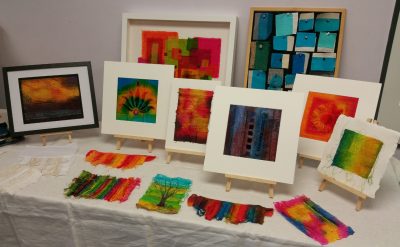
Participants in the Regional summer-school showed other members some of the diverse work that was produced during the 3-day gathering. Branch members took part in two different workshops – a stitch and dye group with Ruth Issett, and a print and stitch group with Faye Maxwell. It was a good opportunity to get to know fellow branch members a bit better, as well as members from other parts of the region, and to get absorbed in our different activities.
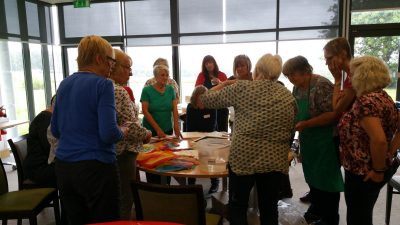
Maria kicked off with a description of the lovely environment at the training centre at Roffey Park, and the excellent facilities and high level of teaching (and yummy food).
Maria introduced the stitch and dye technique that was taught in Ruth Issett’s group. Initial stitching was done in white fabrics and threads, which were then dyed afterwards with procion dye, leading to a surprise each time when the colours were applied.
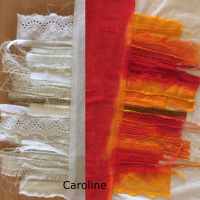 Caroline showed samples that illustrate the technique, where she had cut the sample in half before dyeing and left one half un-dyed. This was a useful record, since other pieces were dyed after stitching so the only record of the ‘white’ stage is in photographs. Other examples below show pieces before and after dyeing.
Caroline showed samples that illustrate the technique, where she had cut the sample in half before dyeing and left one half un-dyed. This was a useful record, since other pieces were dyed after stitching so the only record of the ‘white’ stage is in photographs. Other examples below show pieces before and after dyeing.
The piece by Maria (below) was based on a sunset. It shows the different stages: before dyeing: dyed but not rinsed: rinsed, and finally framed.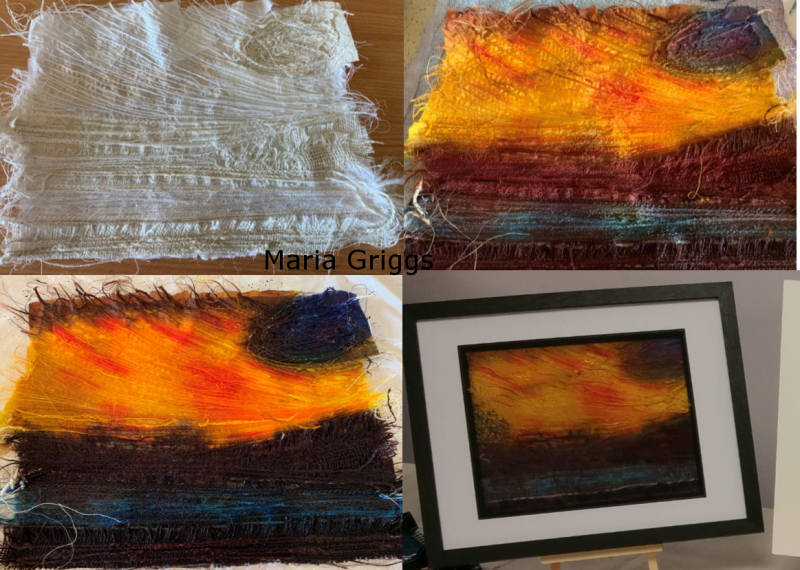
Other branch members went to the workshop with Faye Maxwell, who was a popular tutor at the summer school the year before. Their work started with a choice of printing blocks, which were printed onto plain fabric before being embellished with stitch.
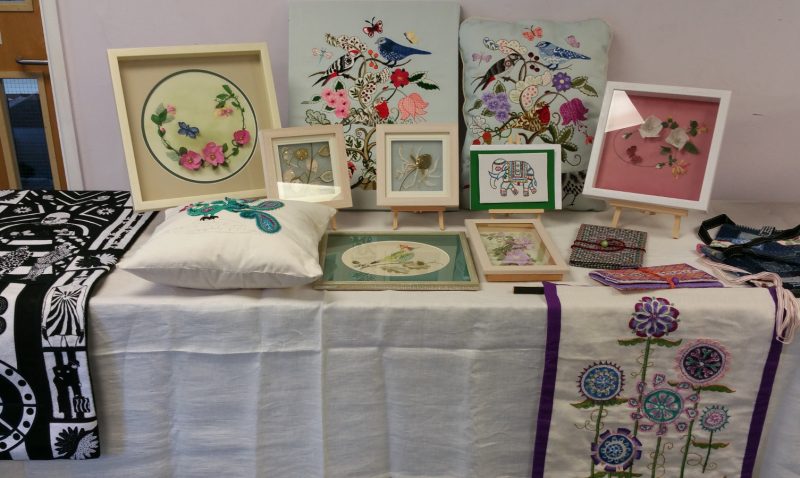
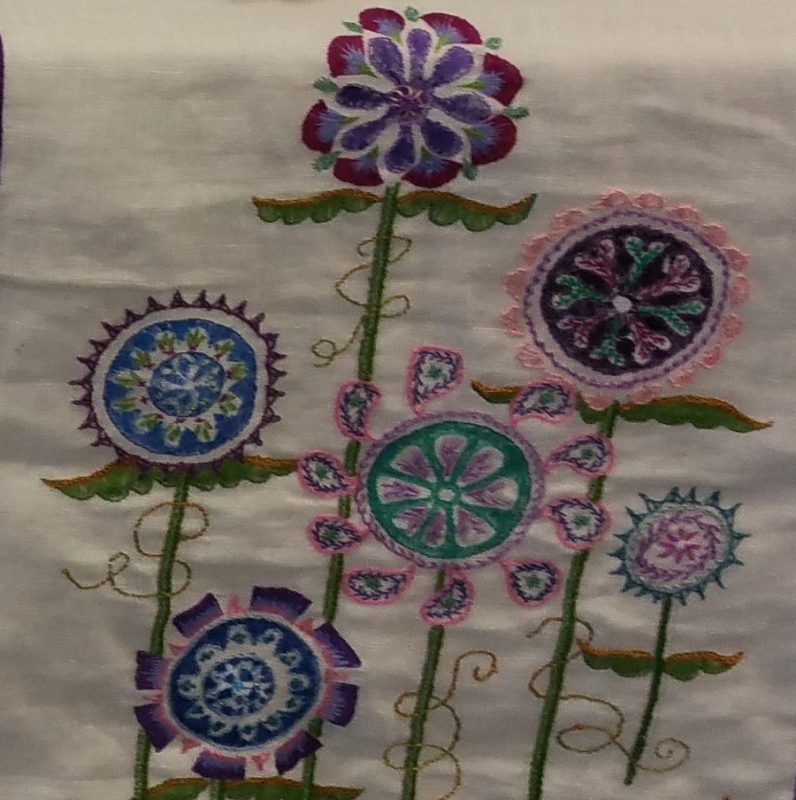
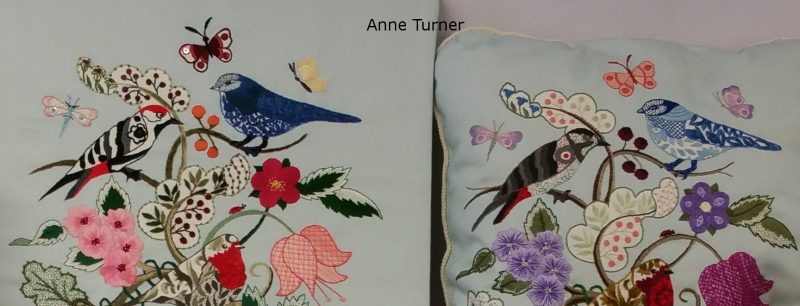
Metal thread creatures
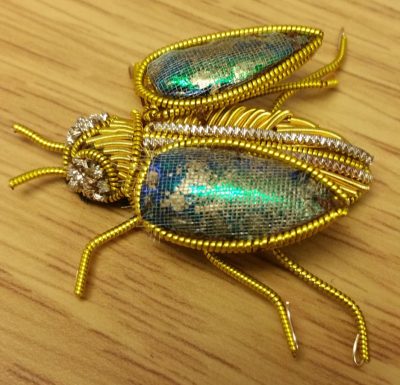 At our July meeting we were treated to a wonderful talk and a show of work by Georgina Bellamy. Georgina specialises in making creatures using her own special approach to metal thread work, which she calls ‘sculptural goldwork’. Her technique produces fantastical three-dimensional creatures.
At our July meeting we were treated to a wonderful talk and a show of work by Georgina Bellamy. Georgina specialises in making creatures using her own special approach to metal thread work, which she calls ‘sculptural goldwork’. Her technique produces fantastical three-dimensional creatures.
Hats off to Georgina, who rose to the challenge of giving her talk without the benefit of the branch digital projector, which we collectively failed to get working. Apparently cool and unfazed by this technical hitch, Georgina went on to deliver a very engaging and entertaining talk, which had her audience fascinated.
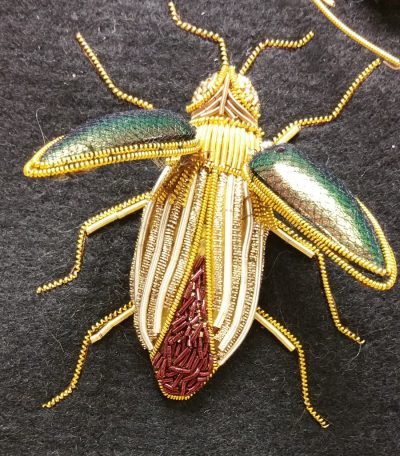 We learned about Georgina’s introduction to stitched textiles, which came in her early twenties, after several other attempts at finding her direction in life. Having never really engaged with formal education, and finding herself as a single-parent working in an unfulfilling job, Georgina decided to make her young son an embroidered jacket. With no embroidery training at all, she produced a garment that made people stop her in the street and ask ‘where did you get it from?’ This was a significant milestone in her passion for stitch.
We learned about Georgina’s introduction to stitched textiles, which came in her early twenties, after several other attempts at finding her direction in life. Having never really engaged with formal education, and finding herself as a single-parent working in an unfulfilling job, Georgina decided to make her young son an embroidered jacket. With no embroidery training at all, she produced a garment that made people stop her in the street and ask ‘where did you get it from?’ This was a significant milestone in her passion for stitch.
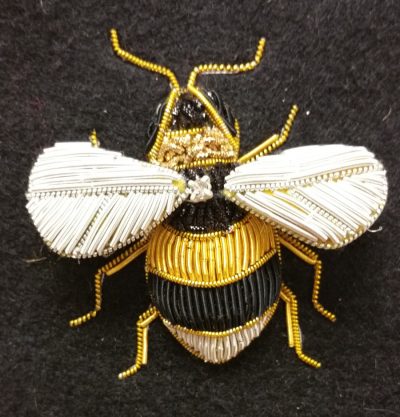 The other turning point was embarking on a City and Guilds Stitched Textiles (Embroidery) course. Georgina was the youngest in the class, and felt she benefited from the experience and encouragement of the older and more experienced members of the course. It was a natural progression from that to a degree at the London College of Fashion. Georgina only mentioned in passing (in response to a question), that at the end of her course she was chosen as one of the Embroiderers Guild Scholars. She had rather modestly not mentioned this during her earlier resume!
The other turning point was embarking on a City and Guilds Stitched Textiles (Embroidery) course. Georgina was the youngest in the class, and felt she benefited from the experience and encouragement of the older and more experienced members of the course. It was a natural progression from that to a degree at the London College of Fashion. Georgina only mentioned in passing (in response to a question), that at the end of her course she was chosen as one of the Embroiderers Guild Scholars. She had rather modestly not mentioned this during her earlier resume!
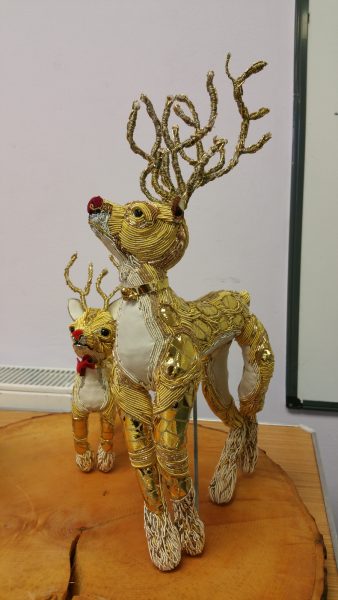 Georgina spoke passionately about the skills and experience of older embroiderers, and how sad it is that many of these skills are falling by the wayside. She spoke about the impact of long working hours, passive entertainment, and the wish to have everything ‘instantly’ rather than making things with patience. Of course there were many nods of agreement from the audience – most of us find it sad that people seem to have less time to help children learn the skills that we were brought up with. Georgina also spoke about how hand-stitch is not part of the ‘mainstream’ in fashion courses, despite the fact that so many high-end designers use embroidery in their designs. The emphasis is often on ‘farming out’ the embroidery, rather than it being taught as a skill in its’ own right. Georgina had to be quite single-minded about focussing on hand-stitch throughout her degree course. She is very pleased she did so as this is now her main passion.
Georgina spoke passionately about the skills and experience of older embroiderers, and how sad it is that many of these skills are falling by the wayside. She spoke about the impact of long working hours, passive entertainment, and the wish to have everything ‘instantly’ rather than making things with patience. Of course there were many nods of agreement from the audience – most of us find it sad that people seem to have less time to help children learn the skills that we were brought up with. Georgina also spoke about how hand-stitch is not part of the ‘mainstream’ in fashion courses, despite the fact that so many high-end designers use embroidery in their designs. The emphasis is often on ‘farming out’ the embroidery, rather than it being taught as a skill in its’ own right. Georgina had to be quite single-minded about focussing on hand-stitch throughout her degree course. She is very pleased she did so as this is now her main passion.
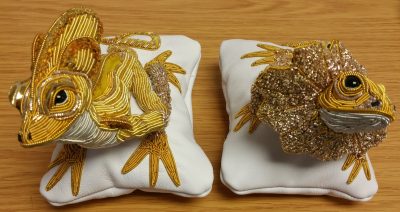 Georgina spoke about the history of gold-work, and the traditions that laid the foundation for gold-work today. She spoke about Spanish, Italian and Russian gold-work, as well as Indian gold-work. She also spoke about the status and historical importance of English gold-work (‘Opus Anglicanum’). Her own work draws on these traditions, and she uses many conventional gold-work materials. However, she doesn’t feel she has to be a slave to tradition, and she likes to use the traditional materials in her own way. Her 3 dimensional creatures are stitched on an organza backing which is then cut out and manipulated into a 3d shape. This requires some planning, as she needs to envisage how the flat shape will translate into the 3d shape once it is manipulated. In her teaching she tries to encourage people not to aim for ‘perfection’. She worries that people often find gold-work intimidating, and she loves to encourage people to ‘just have a go’.
Georgina spoke about the history of gold-work, and the traditions that laid the foundation for gold-work today. She spoke about Spanish, Italian and Russian gold-work, as well as Indian gold-work. She also spoke about the status and historical importance of English gold-work (‘Opus Anglicanum’). Her own work draws on these traditions, and she uses many conventional gold-work materials. However, she doesn’t feel she has to be a slave to tradition, and she likes to use the traditional materials in her own way. Her 3 dimensional creatures are stitched on an organza backing which is then cut out and manipulated into a 3d shape. This requires some planning, as she needs to envisage how the flat shape will translate into the 3d shape once it is manipulated. In her teaching she tries to encourage people not to aim for ‘perfection’. She worries that people often find gold-work intimidating, and she loves to encourage people to ‘just have a go’.
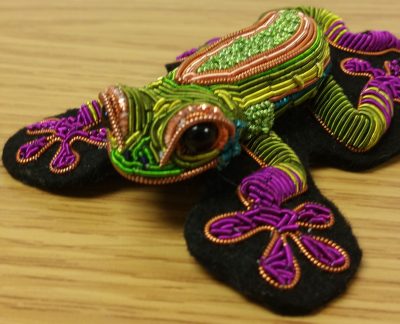 It was interesting to hear a talk from a young embroiderer who is at an early stage of her career. Georgina is passionate about trying to bridge the gap between children and teenagers on the one hand, and on the other hand more (ahem) ‘mature’ embroiderers like ourselves. In the middle, sadly, are working mums who have very little ‘spare’ time, and who often were not brought up to stitch or make things themselves. Georgina passionately believes that it is vital for the skills of the older generation to be passed on and she feels a responsibility to do what she can to help this process. Linked to the embroidery skills are other life-enhancing factors, such as patience, absorption and pleasure. I think Georgina may have reached the record at our talks for the number of heads nodding enthusiastically in agreement!
It was interesting to hear a talk from a young embroiderer who is at an early stage of her career. Georgina is passionate about trying to bridge the gap between children and teenagers on the one hand, and on the other hand more (ahem) ‘mature’ embroiderers like ourselves. In the middle, sadly, are working mums who have very little ‘spare’ time, and who often were not brought up to stitch or make things themselves. Georgina passionately believes that it is vital for the skills of the older generation to be passed on and she feels a responsibility to do what she can to help this process. Linked to the embroidery skills are other life-enhancing factors, such as patience, absorption and pleasure. I think Georgina may have reached the record at our talks for the number of heads nodding enthusiastically in agreement!
Feast for the eyes
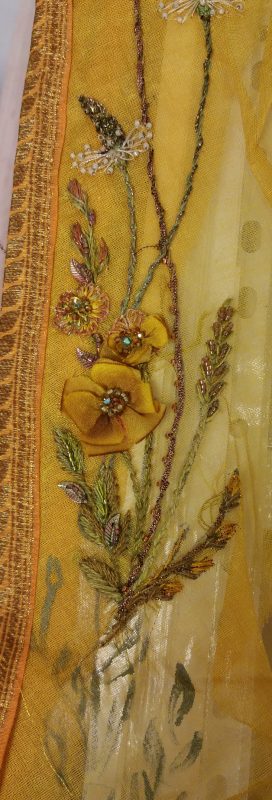 This month’s wonderful talk by Michelle Carragher gave us a fascinating insight into the world of embroidery and costume design for stage and film. The samples of work that Michelle brought with her were a feast for the eyes, and were a wonderful inspiration to us all. Michelle kindly let us photograph some of her work to show on our website. The ‘oohs and ahs’ round Michelle’s sample table after the talk said it all, as well as the length of time that people spent gazing at the work.
This month’s wonderful talk by Michelle Carragher gave us a fascinating insight into the world of embroidery and costume design for stage and film. The samples of work that Michelle brought with her were a feast for the eyes, and were a wonderful inspiration to us all. Michelle kindly let us photograph some of her work to show on our website. The ‘oohs and ahs’ round Michelle’s sample table after the talk said it all, as well as the length of time that people spent gazing at the work.
Michelle talked us through her early introduction to embroidery, from making childhood dolls clothes to a Fashion Design course and then textiles restoration. Restoration work gave her the experience of working quickly and sourcing specialist fabrics and threads. Quite often the piece was too frail to put into an embroidery hoop, so she developed skills in working on un-stretched backgrounds, which was invaluable later on when she worked on fine net and muslin, like the stitch sample on the left.
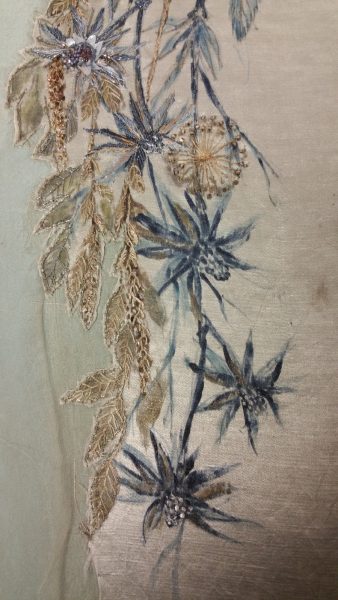 Initially her work on costume embroidery was on amateur productions and then as an intern on bigger films. Her first breakthrough came when she worked for Costume Designer Mike O’Neill, who spotted her talent as an embroiderer and gave her scope for stitched details. She graduated from washing the actor’s socks, to being an integral member of the costume design and making teams.
Initially her work on costume embroidery was on amateur productions and then as an intern on bigger films. Her first breakthrough came when she worked for Costume Designer Mike O’Neill, who spotted her talent as an embroiderer and gave her scope for stitched details. She graduated from washing the actor’s socks, to being an integral member of the costume design and making teams.
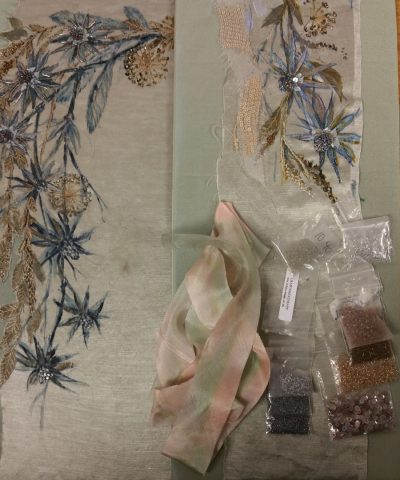 Michelle gave us a fascinating insight into how the costume designer and embroiderer and director work together on an initial concept, through designs and samples to finished item. Anyone who has done City and Guilds Embroidery courses will appreciate the detailed sketches and samples that Michelle brings with her to talks. The samples here were for an elegant Edwardian dress for the film about Gertrude Bell.
Michelle gave us a fascinating insight into how the costume designer and embroiderer and director work together on an initial concept, through designs and samples to finished item. Anyone who has done City and Guilds Embroidery courses will appreciate the detailed sketches and samples that Michelle brings with her to talks. The samples here were for an elegant Edwardian dress for the film about Gertrude Bell.
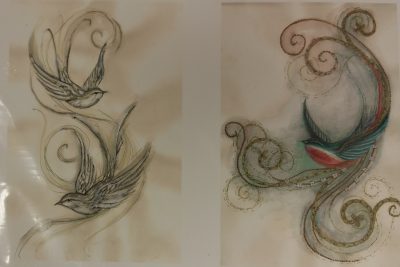 The delicate bird designs on the left show Michelle’s artistic talents, and how an initial idea starts to take shape.
The delicate bird designs on the left show Michelle’s artistic talents, and how an initial idea starts to take shape.
The samples below that were initial ideas for a dress made for Queen Elizabeth I, played by Helen Mirren, which was inspired by traditional embroidery of the time. 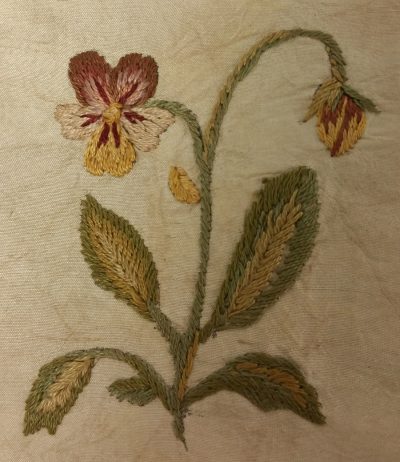 We learned about the painstaking historical research and attention to detail. It is a labour of love; for example, one dress had 350 hand-stitched embroidered roses stitched onto the train. We learned about how roughly these delicate embroideries may be treated, for example if they are in scenes of violence they may get torn or covered in blood. For this reason, some costumes require duplicate sets – sometimes as many as eight. This brought home the importance of the sampling process, and documenting each stage. We also heard about unpredictable aspects of this work; we saw a photo of exquisite embroidery on the neck of a dress for a historical drama, and then we saw the only shot in which it appears – shot from behind, with the actress fleeing away from the camera on a horse, with no sign of the embroidery.
We learned about the painstaking historical research and attention to detail. It is a labour of love; for example, one dress had 350 hand-stitched embroidered roses stitched onto the train. We learned about how roughly these delicate embroideries may be treated, for example if they are in scenes of violence they may get torn or covered in blood. For this reason, some costumes require duplicate sets – sometimes as many as eight. This brought home the importance of the sampling process, and documenting each stage. We also heard about unpredictable aspects of this work; we saw a photo of exquisite embroidery on the neck of a dress for a historical drama, and then we saw the only shot in which it appears – shot from behind, with the actress fleeing away from the camera on a horse, with no sign of the embroidery.
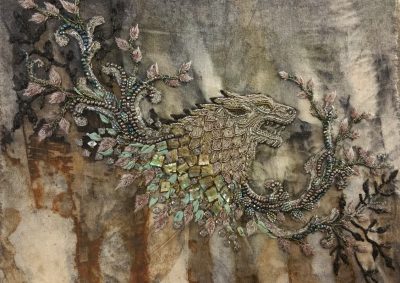 Of course, Michelle is now infamous for the amazing embroidery that she created on the costumes designed with Michelle Clacton for Game of Thrones. She showed us many samples, together with photos of the finished garments ‘in action’. We were in awe of the creative designs, and the interpretations of fantasy ideas, and the inspired use of beads, gemstones, sequins, metal threads, stumpwork, ribbon work etc. Due to the high speed of production on a series like this, many embroideries were created as ‘slips’ on a separate piece of material and then applied to the garment later on, much like the embroidered embellishment of earlier centuries.
Of course, Michelle is now infamous for the amazing embroidery that she created on the costumes designed with Michelle Clacton for Game of Thrones. She showed us many samples, together with photos of the finished garments ‘in action’. We were in awe of the creative designs, and the interpretations of fantasy ideas, and the inspired use of beads, gemstones, sequins, metal threads, stumpwork, ribbon work etc. Due to the high speed of production on a series like this, many embroideries were created as ‘slips’ on a separate piece of material and then applied to the garment later on, much like the embroidered embellishment of earlier centuries.
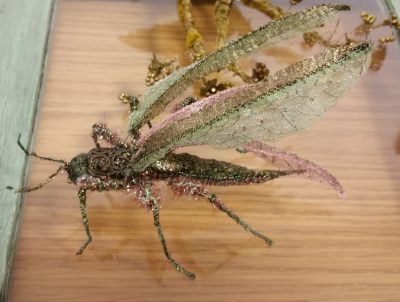 Michelle runs workshops, and anyone who got to see the exhibition this week by Dorking Embroiderers Guild will have seen their collection of fantasy beetles created on a workshop with Michelle recently. This photo doesn’t do Michelle’s creature justice, but wouldn’t a workshop be wonderful! Thanks to Michelle for a really inspiring talk. We learned that she is working on a book – what a treat that will be when it comes out. I already know in June what I’d like for Christmas!
Michelle runs workshops, and anyone who got to see the exhibition this week by Dorking Embroiderers Guild will have seen their collection of fantasy beetles created on a workshop with Michelle recently. This photo doesn’t do Michelle’s creature justice, but wouldn’t a workshop be wonderful! Thanks to Michelle for a really inspiring talk. We learned that she is working on a book – what a treat that will be when it comes out. I already know in June what I’d like for Christmas!
‘The month of leaves and roses’
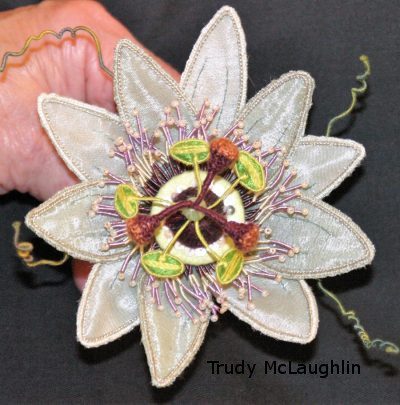 It often strikes me what a lovely overlap there is between gardening and embroidery. It’s the month for wandering round beautiful gardens, smelling the roses and soaking up inspiration for our stitching.
It often strikes me what a lovely overlap there is between gardening and embroidery. It’s the month for wandering round beautiful gardens, smelling the roses and soaking up inspiration for our stitching.
‘It is the month of June,
The month of leaves and roses,
When pleasant sights salute the eyes
And pleasant scents the noses’.
(Nathanial Parker Willis)
If you read this in time, there are still 4 days when you can catch the lovely exhibition of embroidery at Nymans Gardens by Dorking EG Branch, in which all the work is based on the flowers and plants of Nymans. It’s open until Friday 14th; if you read this in time, it’s well worth the trip so do try to go. It’s the perfect month to visit the Nymans rose garden too.
Our most recent meeting was our ‘Members Day’ when we spent the whole day together chatting and stitching, and sharing lunch. We had a wonderful talk by Eileen Blaney on the history of the branch. Eileen has very kindly agreed to write up the notes for her talk so that it can be added properly to the website, together with photos, so I won’t try to summarise her talk here. ‘Watch this space’ as they say! Many thanks Eileen for a very interesting and entertaining talk.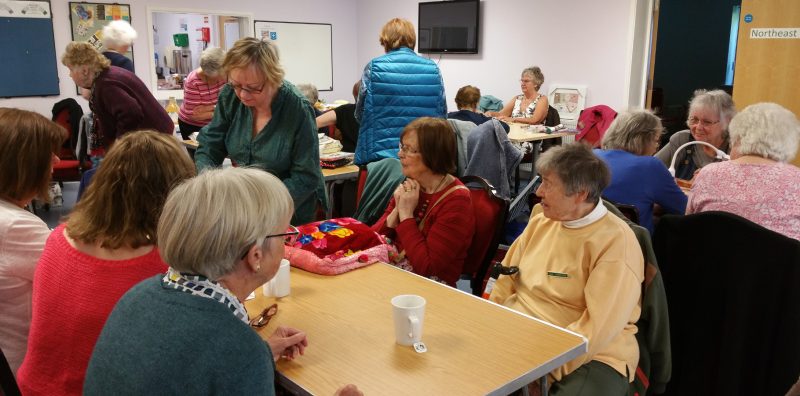
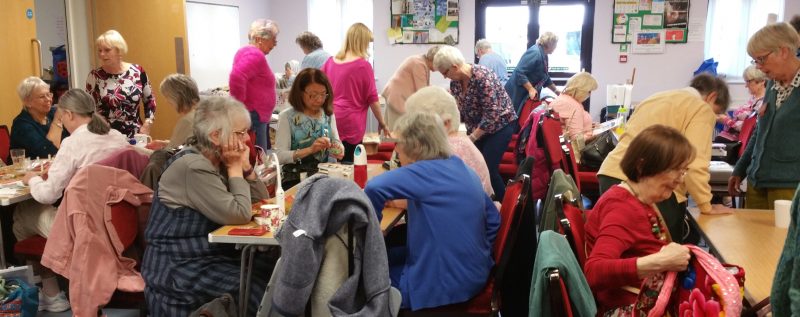
The challenge of colour
I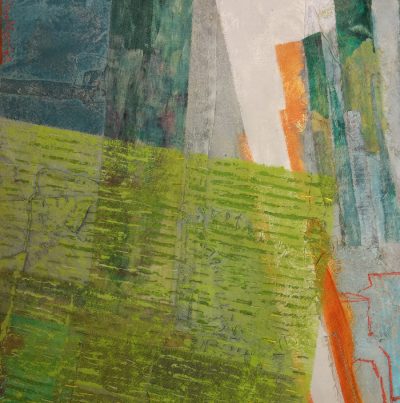 n her talk to WTEG this month, Jae Maries focussed on the use of colour in textile art. This was very timely, as members had recently started to think about the Branch Challenge, ‘Take Two’, which is to make a piece of work using just two colours. Jae emphasised how personal our response to colour is, and how it reflects the mood of the maker and has an impact on the viewer.
n her talk to WTEG this month, Jae Maries focussed on the use of colour in textile art. This was very timely, as members had recently started to think about the Branch Challenge, ‘Take Two’, which is to make a piece of work using just two colours. Jae emphasised how personal our response to colour is, and how it reflects the mood of the maker and has an impact on the viewer.
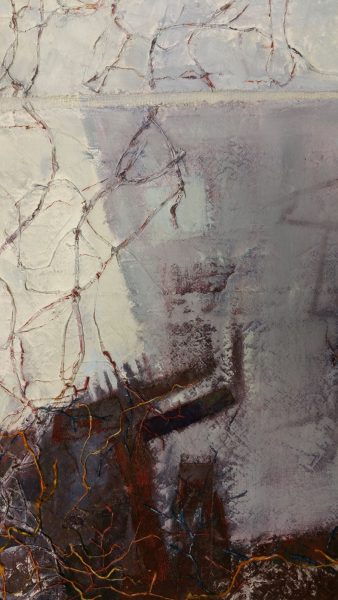 Jae spoke about how colour can create drama in a piece, with the use of contrast, and how this can affect mood. Jae said that she sometimes highlights some quite ‘dark’ issues in her work, for example knife crime and homelessness. She questions the assumption that embroidery has to be ‘pretty’. This piece shows how Jae sometimes uses a very restricted range of colour, emphasising dark and light. This can add to the sense of closeness and distance of the subject, as does the use of cool colours to recede and warm colours to move forward.
Jae spoke about how colour can create drama in a piece, with the use of contrast, and how this can affect mood. Jae said that she sometimes highlights some quite ‘dark’ issues in her work, for example knife crime and homelessness. She questions the assumption that embroidery has to be ‘pretty’. This piece shows how Jae sometimes uses a very restricted range of colour, emphasising dark and light. This can add to the sense of closeness and distance of the subject, as does the use of cool colours to recede and warm colours to move forward.
Jae uses interesting and unusual textures in her work, derived from her painterly background. She uses calico, which she sizes, then primes white; she then paints on top of that and adds textures and more paint. Sometimes stitch is quite dense, and sometimes it is minimal. This piece shows seeding in a contrasting colour, next to areas where the stitch has been painted over to leave a trace behind in the texture. The photo below is from the same piece, based on roads and rice fields in Vietnam. It shows the impact of an individual splash of a contrasting colour: the tiny splash of pink provides a focal point for the whole piece. 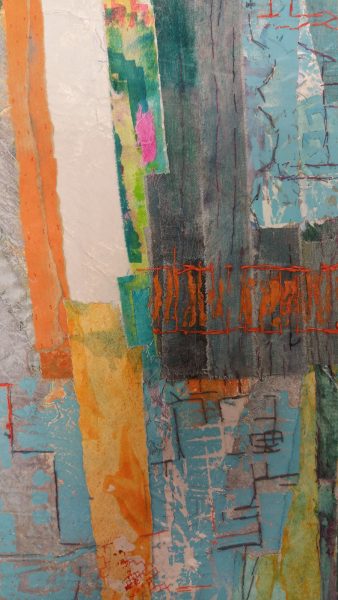 Jae acknowledged that many embroiderers want to create work that is figurative and restful, and based on more traditional techniques. Whilst not criticising that approach, she did encourage her audience to think about playing with colour in a different way and taking some risks. After the talk quite a few people were talking about the ‘Take Two’ branch challenge, so Jae had clearly got people thinking.
Jae acknowledged that many embroiderers want to create work that is figurative and restful, and based on more traditional techniques. Whilst not criticising that approach, she did encourage her audience to think about playing with colour in a different way and taking some risks. After the talk quite a few people were talking about the ‘Take Two’ branch challenge, so Jae had clearly got people thinking.
(Jae’s work is photographed and shared here with kind permission from Jae).

